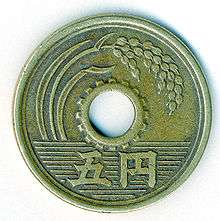Japanese mon (currency)

The mon (文) was the currency of Japan from the Muromachi period in 1336, until 1870. The Chinese character for mon is 文 and the character for currency was widely used in the Chinese-character cultural sphere, e.g. Chinese wen Korean mun. Coins denominated in mon were cast in copper or iron and circulated alongside silver and gold ingots denominated in shu, bu and ryō, with 4000 mon = 16 shu = 4 bu = 1 ryo. The yen replaced these denominations in 1870. However, its usage continued at least into 1871, as the first Japanese stamps, issued in that year, were denominated in mon.[1]
History
Mon coins were holed, allowing them to be strung together on a piece of string.
Through Japanese history, there were many different styles of currency of many shapes, styles, designs, sizes and materials, including gold, silver, bronze, etc.
See also
Currencies with the same etymology
References
- ↑ 2003 Standard Postage Stamp Catalogue, vol. 4. Sidney: Scott Publishing, 2002, p. 15.
Further reading
- Titsingh, Isaac. (1834). [Siyun-sai Rin-siyo/Hayashi Gahō, 1652]. Nipon o daï itsi ran; ou, Annales des empereurs du Japon.] Paris: Oriental Translation Fund of Great Britain and Ireland. ... Click for digitized, full-text copy of this book (in French).
Early Japanese Coins Author David Hartill Publisher New Generation Publishing, 2011 ISBN 0755213653, 9780755213658

